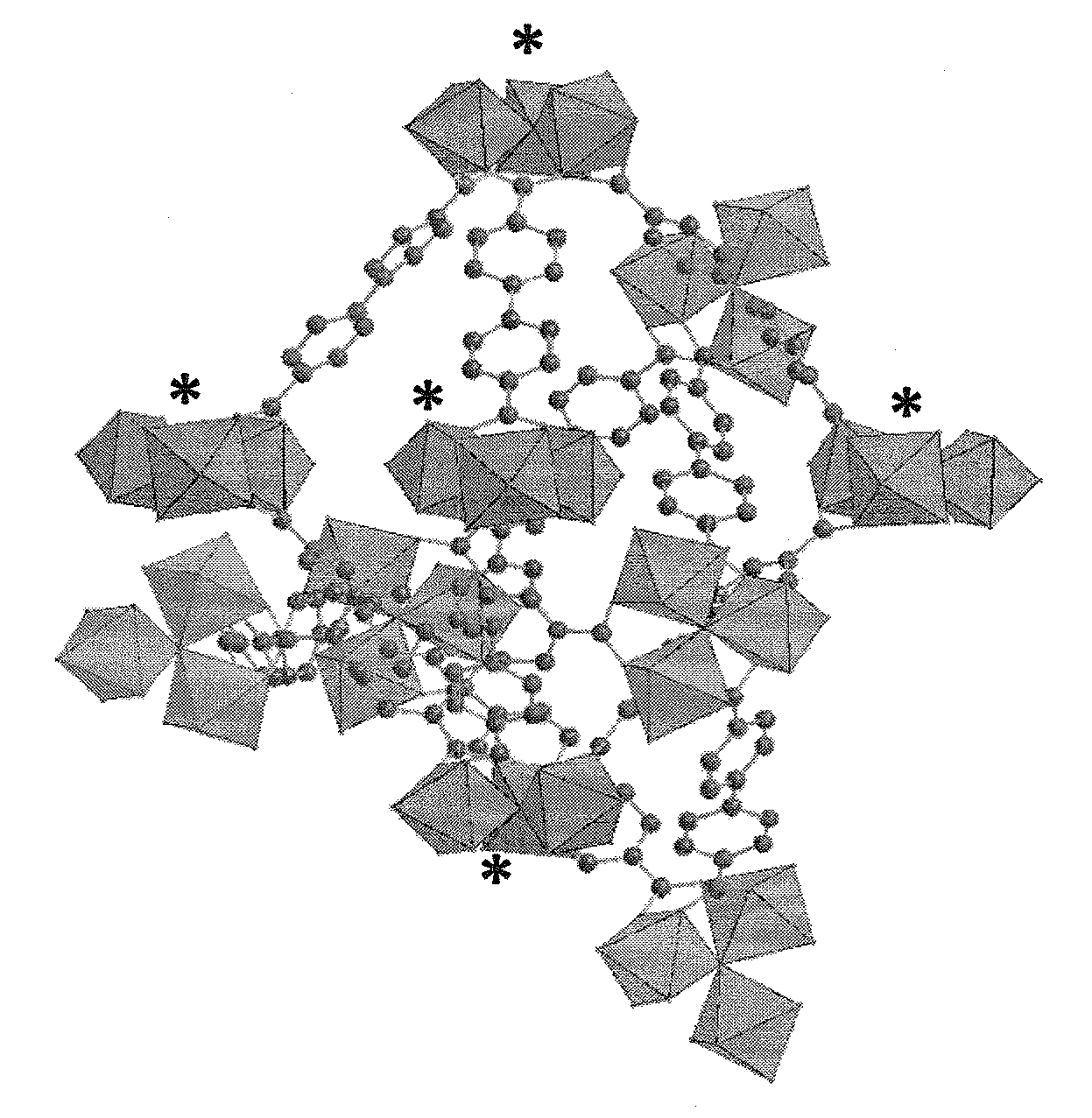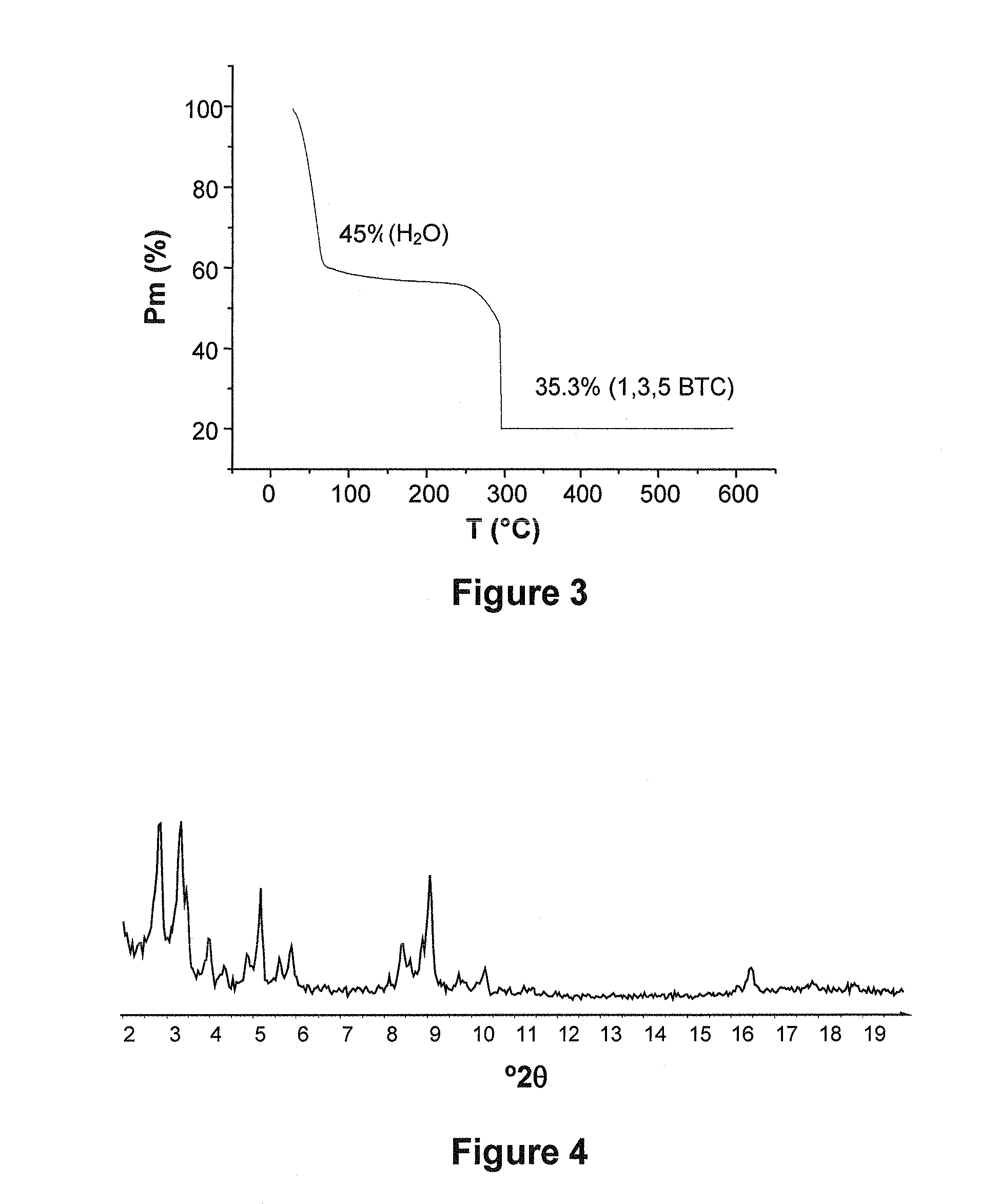Reducible porous crystalline hybrid solid for the separation of mixtures of molecules having different degrees and/or a different number of unsaturations
a technology of porous crystalline solids and hybrid solids, which is applied in the direction of ion exchange treatment of group 3/13 element organic compounds, iron organic compounds, etc., can solve the problems of easy desorption of alkene, small volatility between olefins and paraffins, and major industrial problems such as the separation of mixtures of compounds in gaseous or liquid phase, so as to reduce the duration of synthesis and production costs, reduce the number of steps, and the yield
- Summary
- Abstract
- Description
- Claims
- Application Information
AI Technical Summary
Benefits of technology
Problems solved by technology
Method used
Image
Examples
example 1
Synthesis and Data on Iron Carboxylate MOF Materials of the Present Invention
[0391]This example describes the synthesis of various iron carboxylates. The solids obtained were then characterized according to the methods described below.
[0392]The analysis of the crystal structure of the iron carboxylate solids was performed by X-ray diffraction (X-RAY) using a Siemens D5000 diffractometer (CuKα radiation λCu=1.5406 Å, mode θ-2θ), at ambient temperature in air. The diagrams presented are either in angular distances (2θ, in degrees°) or in inter-reticular distances (d, in Å or Angström).
[0393]The porosity (Langmuir specific surface area and pore volume) of the solids was characterized by nitrogen adsorption at 77 K on a Micromeretics ASAP-2010 instrument. The solids were previously dehydrated at 150° C. under primary vacuum for one night. The isotherm of nitrogen adsorption by the solids is given by a curve showing the volume of nitrogen adsorbed V (in cm3 / g) as a function of the ratio ...
example 2
Synthesis of Ligands
a) Synthesis A: Synthesis of Chloroterephthalic Acid
[0548]6 g (0.043 mol) of chloroxylene (marketed by Aldrich, >99%), 16 ml of nitric acid (marketed by VWR, 70%) and 60 ml of distilled water are introduced into a 120 ml Teflon vessel. This is inserted into a metallic PAAR type bomb, heated to 170° C. for 12 hours. The product is recovered by filtration, then washed thoroughly in distilled water. A 75% yield is obtained.
[0549]1H NMR (300 MHz, d6-DMSO): δ (ppm): 7.86 (d, J=7.8 Hz), 7.93 (dd, J=7.8, 1.2 Hz), 7.96 (d, J=1.2 Hz)
b) Synthesis B: Synthesis of 3,5,3′,5′-tetramethyl-biphenyl-4,4′-dicarboxylic acid
[0550]The reaction scheme for this synthesis is shown in FIG. 20.
1st Step:
[0551]10.2 g of tetramethylbenzidine (98%, Alfa Aesar) are suspended in 39 ml of concentrated hydrochloric acid (37%, marketed by Aldrich) at 0° C. The diazotization was effected by addition of a solution of sodium nitrite (6 g in 50 ml of water). After stirring for 15 minutes at 0° C., a s...
example 3
Determination of the Flexibility of the MOF Materials
[0563]The flexibility of the Fe, Cr, V, Mn and / or Co carboxylate MOF materials can be determined by X-RAY diffraction. The paragraphs that follow indicate a method which can be used to demonstrate the possible flexibility of the MOF materials. In particular, the inventors have demonstrated the flexibility of certain MOF materials named “MIL-88”.
[0564]On reading what follows, the reader will be in a position to adapt the method to establish which of the MOF materials containing a three-dimensional structure of moieties of formula (I) have a rigid structure, and are therefore capable of being used in the process of the invention.
[0565]The category of flexible hybrid solids based on trimers of trivalent transition metals (Fe, Cr, V, Mn . . . ) is named MIL-88. These compounds are typically made up of trimers of iron octahedra, in other words three iron atoms connected by a central oxygen and by six carboxylate groups connecting the i...
PUM
| Property | Measurement | Unit |
|---|---|---|
| Temperature | aaaaa | aaaaa |
| Temperature | aaaaa | aaaaa |
| Fraction | aaaaa | aaaaa |
Abstract
Description
Claims
Application Information
 Login to View More
Login to View More - Generate Ideas
- Intellectual Property
- Life Sciences
- Materials
- Tech Scout
- Unparalleled Data Quality
- Higher Quality Content
- 60% Fewer Hallucinations
Browse by: Latest US Patents, China's latest patents, Technical Efficacy Thesaurus, Application Domain, Technology Topic, Popular Technical Reports.
© 2025 PatSnap. All rights reserved.Legal|Privacy policy|Modern Slavery Act Transparency Statement|Sitemap|About US| Contact US: help@patsnap.com



